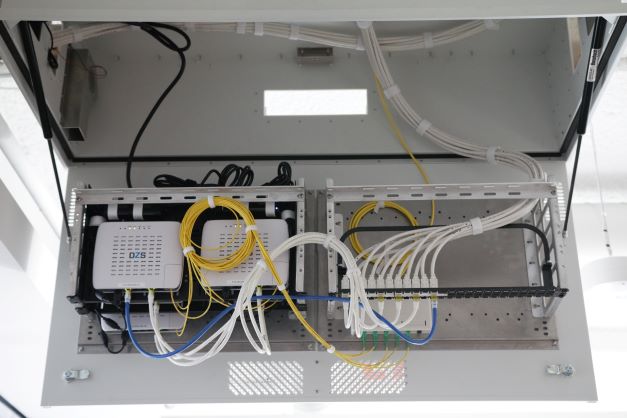When you hear the term “low-voltage cabling,” it might sound like something reserved for engineers or IT professionals. But if you’re responsible for managing an office or coordinating a renovation, understanding low-voltage wiring can help you make smarter, more cost-effective decisions, especially when it comes to network infrastructure, security, and communications.
This guide breaks down what low-voltage cabling is, what systems it supports, and why it matters for modern office spaces.
What Does “Low-Voltage” Actually Mean?
In commercial buildings, electrical systems are typically divided into two categories:
- Line-voltage (high voltage): These are the standard 120V–240V electrical systems that power outlets, lighting, HVAC systems, and appliances.
- Low-voltage: These systems operate at 50 volts or less and are designed for data, communication, and control.
Low-voltage cabling transmits signals, not power, and is used to connect devices like computers, phones, security systems, cameras, audiovisual equipment, and Wi-Fi access points.
Examples of Low-Voltage Systems in Offices
If your building has any of the following, it relies on low-voltage cabling:
- Internet and networking systems (Ethernet, routers, modems, switches)
- VoIP phone systems
- Access control systems (keycard readers, badge scanners)
- Security cameras (CCTV)
- Intercoms and paging systems
- Audio/visual (AV) systems for conference rooms
- Alarm systems and motion sensors
- Wireless access points (Wi-Fi)
Each of these systems requires its own type of low-voltage wiring, designed to carry data quickly and reliably over varying distances.
Why It Matters for Office Managers and Facility Teams
Office managers are often involved in planning renovations, office relocations, or tech upgrades. Low-voltage cabling might not be visible after installation, but it directly impacts how well your team can communicate, collaborate, and stay secure.
Here’s why understanding low-voltage cabling is valuable:
1. Planning Ahead Saves Time and Money
Running cables after walls and ceilings are finished is significantly more expensive and disruptive. Coordinating low-voltage cabling installation during a build-out or renovation ensures all systems are integrated properly from the start.
2. Future-Proofing Your Office
The demand for faster internet, more devices, and smarter office technology is only growing. Investing in the right low-voltage infrastructure now can help avoid costly upgrades later.
3. Reduces Downtime and Maintenance Issues
Proper low-voltage cabling isn’t just about running wires—it involves planning the layout, labeling cables, protecting them from interference, and organizing them neatly in trays and racks. A clean, well-labeled system makes troubleshooting faster and minimizes downtime.
Common Misconceptions About Low-Voltage Wiring
Many office managers assume IT staff or electricians will handle all wiring needs, but low-voltage cabling is its own specialty.
- Electricians usually focus on high-voltage power systems.
- IT teams may manage devices, but not necessarily the cabling infrastructure behind the walls.
Low-voltage contractors like Systcom are specifically trained to design, install, and test the cabling systems that keep your communications and security systems running smoothly.
How Systcom Supports Low-Voltage Cabling Projects
Systcom works with business owners, office managers, and general contractors to design and install low-voltage systems that meet each organization’s unique needs. Whether you’re outfitting a new office, upgrading your conference room, or preparing for an access control system, we’ll help you plan a cabling strategy that’s clean, organized, and future-ready.
We don’t just pull cables, we provide end-to-end support that includes:
- Site surveys and infrastructure assessments
- Detailed cabling plans and schematics
- Integration with IT, security, and AV systems
- Labeling, cable management, and documentation
- Testing and certification for performance and compliance
Not Sure Where to Start? Let’s Talk.
If you’re overseeing an office project and low-voltage cabling is part of the puzzle, it’s worth getting expert input early in the process. The right foundation can save you time, money, and headaches for years to come.
Contact Systcom today to schedule a consultation and find out how we can help you build the backbone of your office technology, from data to security and beyond.
